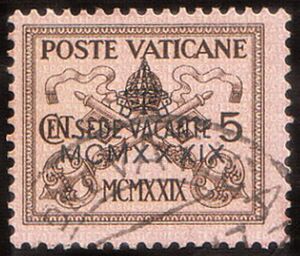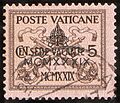Sede vacante facts for kids
Sede vacante is a Latin phrase used in the Catholic Church. It means "the seat is vacant." This term describes a time when a diocese (a church area) or archdiocese (a larger church area) does not have a prelate (a high-ranking church leader like a bishop or archbishop) in charge. The "seat" refers to the leader's official chair, called a cathedra, in their main church.
The term is most often used when the position of the pope is empty. This happens after a pope dies or chooses to step down. For example, if Pope Francis were to die or resign, the papacy (the Pope's office) would be sede vacante.
Contents
What Happens When the Pope's Seat is Empty?
When a pope dies or resigns, the Holy See (the Pope's main office and the central government of the Catholic Church) enters a period of sede vacante. The "vacant seat" is the special chair in the Archbasilica of St. John Lateran, which is the Pope's cathedral church in Rome.
During this time, a group of high-ranking church leaders called the College of Cardinals takes over running the Holy See. However, their power is very limited. Most of the heads of the different church departments stop working in their roles.
- The Cardinal Camerlengo is an important exception. He is in charge of managing the properties and money of the Holy See.
- Another exception is the Major Penitentiary, who continues his normal duties. If either of these leaders needs to do something that usually requires the Pope's approval, they must get permission from the College of Cardinals.
- Papal legates, who are like ambassadors for the Pope, continue their diplomatic work in other countries.
- The Vicar General of Rome and the Vicar General for the Vatican City State also continue their roles in looking after the people in Rome and Vatican City.
The Vatican City State even makes special postage stamps for this time, which are called sede vacante stamps.
Symbols of a Vacant Papacy
The official symbol of the Holy See also changes during this period. The Pope's special crown, called the papal tiara, is replaced with a special umbrella called the umbraculum (or ombrellino in Italian). This umbrella shows that there is no Pope currently in charge. It also shows that the Camerlengo is managing the Holy See's affairs.
The Camerlengo also adds this umbrella to his own family symbol (his coat of arms) during this time. He removes it once a new Pope is chosen. In the past, the Camerlengo's symbol appeared on special Vatican coins. Now, it appears on Vatican euro coins.
Choosing a New Pope
The time when the Pope's seat is empty usually includes:
- The funeral service for the Pope who passed away.
- Meetings of the College of Cardinals to plan the election.
- The papal conclave, which is a special meeting where the cardinals vote to elect a new Pope.
Once a new Pope is elected, the sede vacante period officially ends. This happens even before the new Pope's official start ceremony.
Cardinals who are in Rome usually wait up to 15 days after the Pope's seat becomes empty before they start the conclave. They can extend this time by five more days if the College of Cardinals votes for it. After 20 days, they must start the conclave, even if some cardinals are not there yet.
Historically, these periods without a Pope could last for many months or even years. This was often because the cardinals had trouble agreeing on a new leader. For example, the longest period without a Pope in the last 250 years was from 1799 to 1800. This was when Pope Pius VI died in prison, and it took about half a year to elect Pope Pius VII.
Vacant Catholic Dioceses
The term sede vacante can also be used for other Catholic dioceses and archdioceses around the world, not just for the Pope's seat. This means that the local bishop or archbishop has either died, resigned, moved to a different area, or lost his job. A new leader has not yet been officially put in place.
If there is a coadjutor bishop (a special assistant bishop who is already chosen to take over), then there is no sede vacante period. The coadjutor bishop immediately becomes the new leader.
How a Diocese is Managed When Vacant
Within eight days of a bishop's seat becoming empty, a group of church advisors called the college of consultors (or a cathedral chapter in some places) must choose a temporary leader. This temporary leader is called a diocesan or archdiocesan administrator. This administrator must be a priest or bishop who is at least 35 years old.
If the advisors cannot choose a suitable person in time, the choice goes to the metropolitan archbishop (the leader of a larger group of dioceses). If that position is also empty, then the oldest suffragan bishop (a bishop under the metropolitan) makes the choice.
The pope can also choose an administrator himself. This person is called an apostolic administrator. Often, a retired bishop from that area might be chosen for this role. If the chosen apostolic administrator is already a bishop of another diocese, he will temporarily lead both his own diocese and the vacant one.
Before an administrator is chosen, the local auxiliary bishop (an assistant bishop) takes charge. If there are several, the oldest one does. If there are no auxiliary bishops, the college of consultors as a group takes charge.
The administrator has many of the same powers as a bishop, but with some limits. For example, the administrator may not sit in the main bishop's chair (the cathedra) because it symbolizes the permanent leader's office. The administrator only serves temporarily.
Symbols and Prayers During a Vacancy
During a sede vacante period in a diocese, the official symbol (coat of arms) of the last bishop or archbishop might still be used. This helps show that the church area is still connected to its past leadership while waiting for a new one. Once a new bishop is installed, his own coat of arms will be used.
Also, during church services like Mass, the name of the bishop or archbishop is not mentioned in the main prayer until a new one is in place. Instead, the prayer might say "and all the clergy" or "the Order of Bishops." However, if the temporary administrator is himself a bishop, his name might be mentioned as "our Administrator" or "our Bishop."
Images for kids





